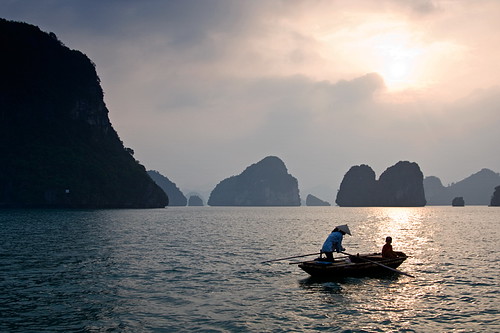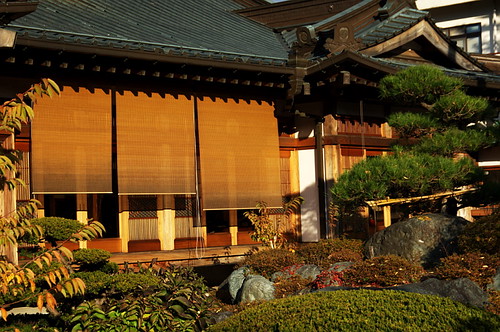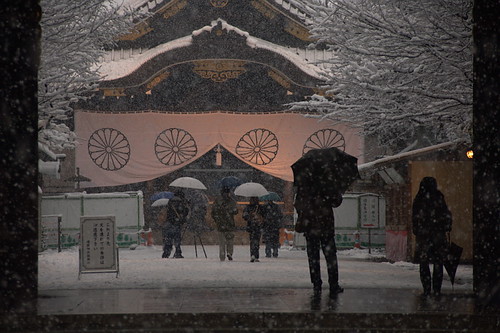Friday, July 23, 2010
Todai-ji – UNESCO World Heritage
With Akiko, we always had some interest for the cultural Unesco sites. Nara, city located near the famous Kyoto doesn’t get the interest level it deserves. It is however a must for any visitor to Japan.
Nara (Heijo-kyo) was, in 710 the first capital of the then Yamato state. Among the numerous touristic spots to see, our favorite is without doubt the Daibutsu, Great Buddha, hosted in the Todai-Ji temple.
This Todaïjï temple and the Daibutsu, great Buddha, are THE symbol of Nara. Built in 743 on the order of Emperor Shomu, this Buddha was finished in 752. Like all Japanese wooden temples, this structure burnt twice during the centuries, in 1180 and 1567. The current building protecting the great Buddha was built in 1709. This Daibutsu Vairochana statue is 16 meter tall and weights some 450 tons. The wooden structure hosting the Daibutsu is 47 meter high, 57 meter long and 50 meter wide – it is the largest wooden structure in the world!
Sunday, July 11, 2010
Japan Nostalgia

The two villages, Shirakawa-go and Gokayama, containing numerous Gassho-zukuri style houses were added to the Unesco World Heritage list in 1995. Located in a mountainous region that was cut off from the rest of the world for a long period of time, these villages with their Gassho-style houses subsisted on the cultivation of mulberry trees and the rearing of silkworms. The large houses with their steeply pitched thatched roofs are the only examples of their kind in Japan.

We visited this place twice, at different season. In August, the rice paddies are green and the scenery is quiet.

One can quickly understand the purpose of these steeply pitched thatched roofs.
Nowadays, one of the main activity of the place is Tourism. I’ve heard that some 1.5 million visitors come every year !
The view of the various night lighting is wonderful and helps to forget about the freezing cold.
Saturday, November 21, 2009
A thought for Brasilia
Nothing special. Just the wish to write something.
I was looking for photos from Brazil when I came across this one. What good memories! Brasilia is a very special city, thanks to its concept, its creation and its symbolism. We have been fortunate to discover it with a guide who was really in love with this city and was able to make us share his enthusiasm.
We are very grateful to him for sharing his passion with us.
Saturday, April 18, 2009
Uzbekistan
Uzbekistan, I must confess that we knew almost nothing of that country before deciding to go. Of course, the main reasons for this travel destination choice had names like Silk Road, Samarkand, Bukhara and Tamerlane. But it would have been hard to to provide more details and respond to simple questions such as: actual location of the country, history, current data, etc..
So, the first travel guide let us know that the country which was, up to the late 1800s divided into several small independent nations called khanates, was conquered by the Russians in the late nineteenth century.
Uzbekistan, as a single nation and republic exists only since 1924, when various territorial entities of Central Asia were united in the Uzbek Soviet Socialist Republic. Uzbekistan is an independent country since 1991.
A century of Russian influence has of course not completly disappeared, but the country still retained its specificity and its national character. We were pleasantly surprised by the friendliness of the people, for their hospitality.



Thursday, April 16, 2009
The Halong Bay, Vietnam
Most probably one of the world most beautiful natural site. A UNESCO World Heritage site since 1994.
A couple of thousands islets spread around some 1500 square kilometers of the emerald water of the Gulf of Tonkin. These thousands limestone pillars and isles of various sizes and shapes are all around, disappearing in the distance in the mist in a mysterious atmosphere.
The legend of the dragon
Local legend has it that long ago, when the Vietnamese were fighting Chinese invaders, the gods sent a family of dragons to help defend the land. This family of dragons began spitting out jewels and jade. These jewels turned into the islands and islets dotting the bay, linking together to form a great wall against the invaders. The people kept their land safe and formed what later became the country of Vietnam. After that, dragons were interested in peaceful sightseeing of the Earth and decided to live here then. The place where Mother Dragon flew down was named Hạ Long, the place where the dragon children attended upon their mother was called Bai Ti Long island, and the place where the dragon children wriggled their tails violently was called Bach Long Vi island.
Monday, April 13, 2009
Inn - Around Fujigoko
I always found that in Japan, the colors of the end of Falls were spectacular. Here a traditional inn at sunset.
I love the little deck of traditionnal Japanese country houses that are meant to allow you to just relax, have a cup of tea or simply read a few pages, while standing in front of a garden that is usually very well taken care of.
Near Mount Fuji, Japan
Friday, April 10, 2009
Yasukuni Jinja
I took this photo during the last winter we spent in Tokyo. Within a few hours, the city was covered with snow and almost all the vehicles stopped running around. The atmosphere was quite special, mainly at nightfall.
The entrance of the Shinto temple Yasukuni Jinja had not been deserted by people.
Yasukuni Jinja, Tokyo, Japan











